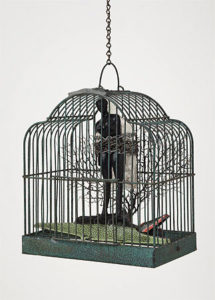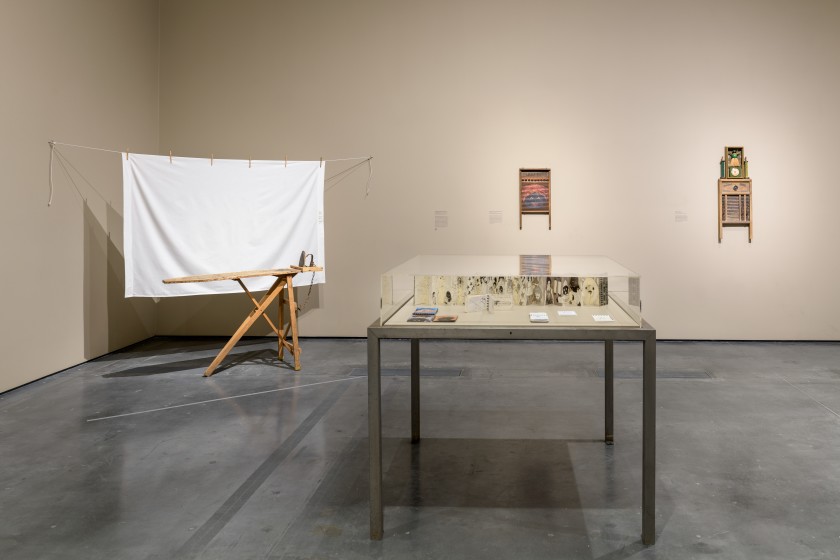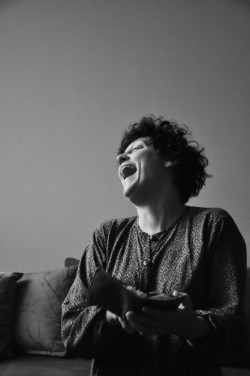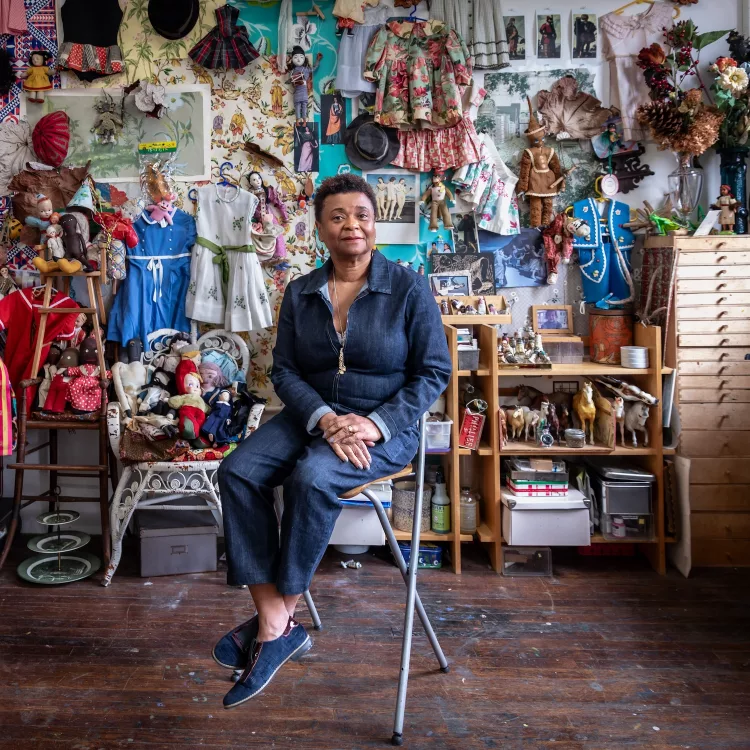Review
Exhibition view: Betye Saar: Call and Response, Los Angeles County Museum of Art, 22 September 2019-22 April 2020, © Photo: Museum Associates/LACMA
Call and Response is the first time the Los Angeles County Museum of Art (LACMA) is showing some of the sketchbooks that the African-American artist Betye Saar (born in 1926) uses as part of her creative process.
The exhibition, curated by Carol S. Eliel in close collaboration with B. Saar, focuses on eighteen works and a selection of sketches made between 1968 and 2019. The exhibition’s title refers to a musical practice from cultures of the African diaspora, which consists in a back-and-forth exchange between the musicians and the audience. The title describes the way objects reach out to the artist to have her tell their story, and is manifested in the pattern in which the works are laid out, creating a to-and-fro motion between the sketches presented on tables in the centre of the room and the sculptures placed along the walls.

Betye Saar, A Loss of Innocence, 1998, vintage dress, hanger, chair, and framed photo, 76.2 x 30.48 x 30.48 cm, 50 x 12 x 12 in. (dress on hanger); 43.18 x 20.32 x 17.78 cm,; 17 x 7 ¾ x 7 in. (chair), Courtesy Betye Saar & Roberts Projects, Los Angeles, © Betye Saar, Photo : Courtesy Scottsdale Museum of Contemporary Art, Scottsdale, © Tim Lanterman
For B. Saar, the practice of assemblage is a way of revisiting the properties of objects that she finds in Los Angeles markets or during her travels, by investing them with emotional value and political significance. From the start of the exhibition, a series of pieces featuring dresses show the artist’s desire to expose the subtle outlines of the black experience. A Loss of Innocence (1998) is a sculpture comprised of a delicate lacy white dress suspended from a hanger over a children’s chair, on which a photograph of a little black girl has been placed. Despite the seemingly peaceful nature of the installation, the blistering violence of the words written on the dress’s hem – insults against black children – spine-chillingly commands our attention.

Betye Saar, Page from 2009–10 sketchbook, 2010, ballpoint pen, marker and colored pencil on paper, 12.7 x 10.2 cm, 5 ½ x 4 in., Collection of Betye Saar, Courtesy Betye Saar & Roberts Projects, Los Angeles, © Betye Saar © Photo: Museum Associates/LACMA
B. Saar appropriates this violence in order to turn it against her persecutors. I’ll Bend but I Will Not Break (1998), an installation comprised of an iron and ironing board in front of a white sheet attached to a line with clothes pegs, affirms the unwavering resistance of the black community in the face of a political system inherited from slavery. The assemblage of household items typically associated with women speaks to the central role they played in this struggle, while the white sheet references the Ku Klux Klan. On the ironing board, an 18th-century picture shows men being piled into a slave ship bound for the American continent. The piece refers to the branding of slaves in captivity. This highly political installation closes the exhibition, and is enhanced by a filmed interview of the artist explaining its meaning.

Betye Saar, The Edge of Ethics, 2010, mixed-media assemblage, 25.4 x 22.8 x 12.7 cm, 10 ½ x 9 ¼ x 5 ½ in., Courtesy Betye Saar & Roberts Projects, Los Angeles, © Betye Saar © Photo: Museum Associates/LACMA
The Edge of Ethics and Serving Time (both 2010) use the symbolism of cages to express the notion of captivity. Both these works convey the suffering of the men and women who endured slavery and the continuing discrimination that stem from this system. In The Edge of Ethics, the suffering appears to be signified by the fact that the central black figure, chained to a small vial that they carry like a burden, is shown standing on the back of an alligator, in a position where it is vulnerable to the creature’s voracity. The figure’s bird-like feet are reminiscent of African-American writer and activist Maya Angelou’s image of the caged bird.1

Exhibition view: Betye Saar: Call and Response, Los Angeles County Museum of Art, 22 September 2019-22 April 2020, © Photo: Museum Associates/LACMA
Call and Response reflects the artist’s harsh view of her country, as well as the painstaking care with which she examines the rites that enable men and women to be part of society and survive. Her personal life and research into spirituality are the inspiration behind her reinterpretation of objects, and the sketches presented in the exhibition provide a glimpse into the symbols that constitute her vocabulary, particularly the religious icons that she discovered in Mexico and Brazil.
In addition to this exhibition, on 21 October New York’s Museum of Modern Art opened an in-depth exploration of the development of this symbolic artistic language with the exhibition The Legends of Black Girl’s Window, a collection of engravings and drawings created in the 1960s and 1970s around a pivotal piece in the artist’s work, Black Girl’s Window (1969).
Both these exhibitions are a testament to the growing visibility of B. Saar’s work in American institutions. The Ludwig Museum in Cologne recently awarded her the prestigious Wolfgang Hahn Prize for 2020, hopefully pointing to the artist’s rightfully deserved acknowledgement worldwide.
Call and Response, 22 September 2019–5 April 2020, Los Angeles County Museum of Art, (Los Angeles, United States).
I Know why the Caged Bird Sings, New York, Random House, 1969.
The author received support from the Terra foundation for American Art to write this article.
Adiva Lawrence, "Betye Saar, from assemblage to resistance." In Archives of Women Artists, Research and Exhibitions magazine, . URL : https://awarewomenartists.com/en/magazine/betye-saar-de-lassemblage-a-la-resistance/. Accessed 27 December 2025












